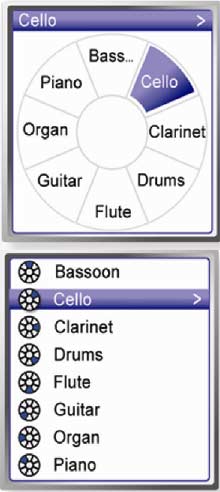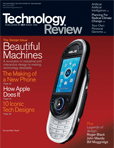|
Tuesday, May 08, 2007 Audio Menus for iPodsResearchers are testing ways to let people listen to gadget menu options instead of looking at them. By Kate Greene
Clicking through the menu on your iPod demands a significant amount of visual attention, which can be a hassle (while jogging) and even dangerous (while driving). But engineers at the University of Toronto and Microsoft Research are working on software that could make it possible to navigate the menus of gadgets that use circular touch pads, like the iPod, without looking at them--only audio cues would be used. The researchers have designed an auditory menu technique--called earPod--that provides audio feedback when a person drags his or her finger around the touch pad. Although it's not ready to replace the expansive menus on real iPods, the results are encouraging, says Patrick Baudisch, a research scientist at Microsoft Research, in Seattle, who worked on the project. Within 30 minutes of beginning to use the technology, people can navigate two levels of earPod menus faster than traditional visual menus, and just as accurately. "Requiring constant visual attention while using a PC is reasonable," says Baudisch, "but if you're using an iPod on the road, [constant visual attention] is unreasonable." In addition to giving people back their eyes, he says, audio menus could help gadgets save battery life by not wasting energy on a screen, and they could add functions to the screen-free devices such as the iPod shuffle. The idea of using audio menus isn't new. Auditory interfaces can, after all, be found in touch-tone phone menus and in various assisted technologies for seeing-impaired users. But historically, handheld consumer gadgets haven't widely used audio menus. There are a few reasons for this, says Bruce Walker, professor in the school of psychology and college of computing at Georgia Institute of Technology. One reason, he says, is that audio hardware and software have been resource intensive, requiring significant amounts of computation and energy. In addition, audio software has been difficult to program. But computing power is becoming cheaper, and there is an increasing need to find different ways to interact with handheld devices, says Walker. Within the past 10 years, he says, the ubiquity of mobile devices with small displays "has made us all visually impaired." Currently there are only a handful of researchers who are systematically looking at ways to make better audio interfaces for various devices, but Walker expects the ranks to grow in the coming years. This first earPod prototype has a two-level menu hierarchy with 8 items per category, for a total of 64 items. To test how well people use the system, the researchers assigned to the first menu level a random assortment of categories: "clothing," "fish," "instrument," "color," and four others. The next level contained eight examples of these items. The iPod analogy would be found in the opening menu, which includes "music," "extras," "settings," and then lower menus that include "playlists," "artists," and "albums," for instance. The earPod approach could be extended to read off a limited number of names of artists and songs as well. |
 |
||||||
|
||||||

 Add to Facebook
Add to Facebook



Comments